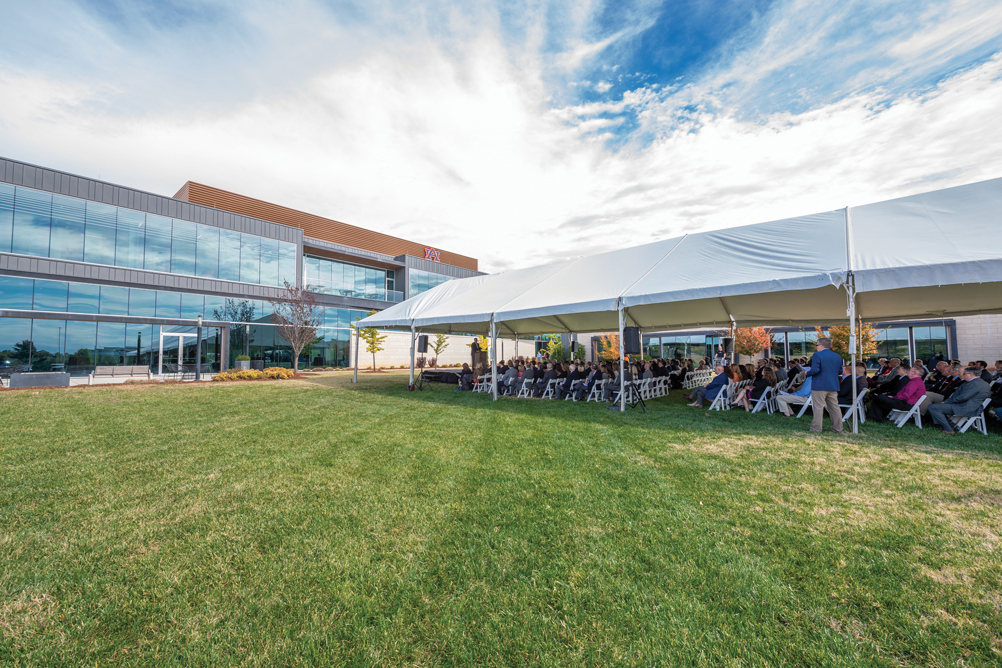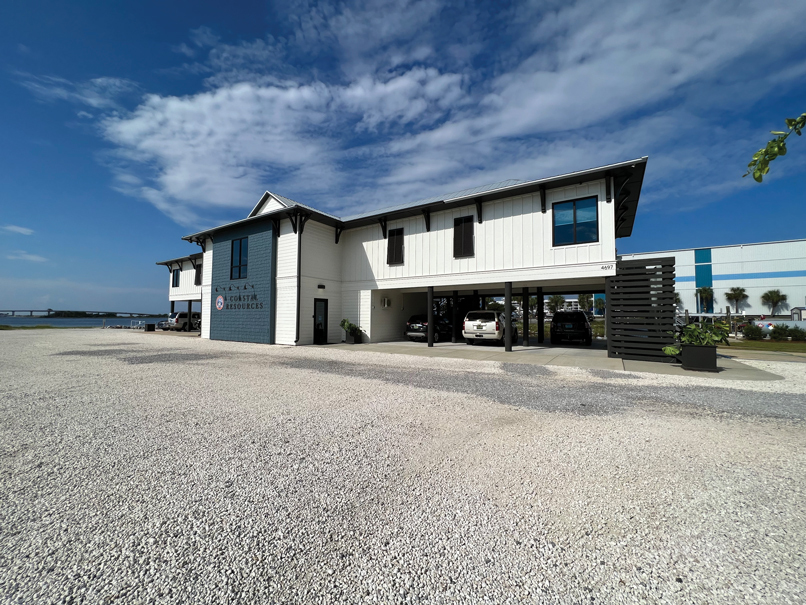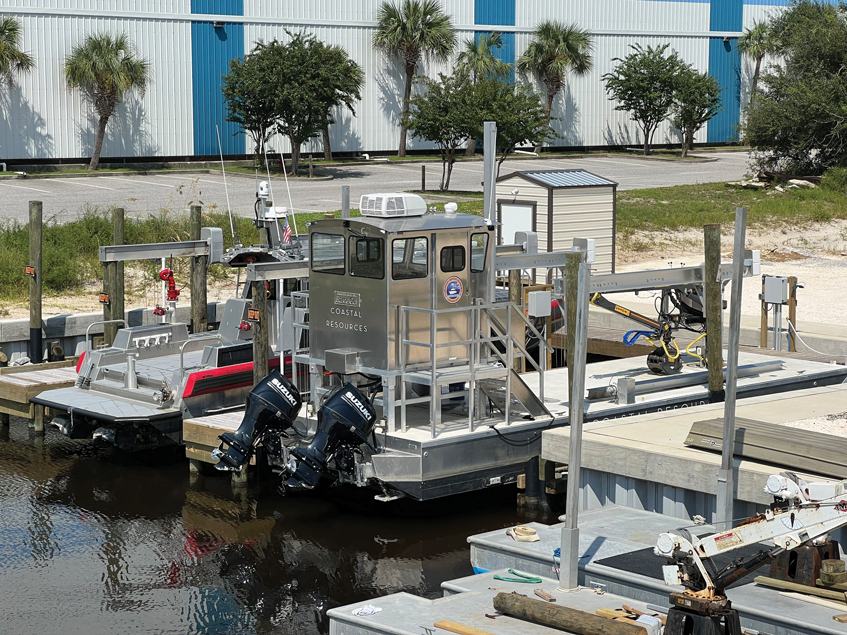
HUNTSVILLE, THE WAR EAGLE HAS LANDED.
Auburn University expanded its footprint and opened its doors to a new facility in Huntsville in October with the grand-opening celebration of the Research and Innovation Campus.
The 9-acre property, located at 345 Voyager Way NW in Huntsville’s Cummings Research Park, is in close proximity to numerous defense and aerospace collaborators, as well as the Bridge Street commercial development and the Gate 9 entrance to Redstone Arsenal.
“Much like Neil Armstrong and Buzz Aldrin did in 1969, today is a monumental day for Auburn as we plant our flag in Huntsville,” said Steve Taylor, interim dean of Auburn’s Samuel Ginn College of Engineering. “We might even say that a different eagle has landed.”
The property, which formerly housed LogiCore, is well equipped to support applied research and development work for Huntsville/Redstone customers as well as hosting alumni and advancement events. Designed to foster a new era of interagency and interdisciplinary collaboration necessary to secure the nation into the next century, the Auburn University Research and Innovation Campus will serve as a state-of-the-art, multi-million-dollar collaboration engine, conference center and research space that extends Auburn’s expertise and next-generation resources to the defense, space and law enforcement agencies.

“The Auburn University Research and Innovation Campus will be where today meets tomorrow,” said Auburn University President Chris Roberts. “Huntsville has been, and will continue to be, one of the hotbeds for our graduates to work, our faculty to partner and our students to explore. The facility will fast-track career connections that change the world, not only through the opportunity for next-generation cross-domain collaboration among agencies, but by supplying our partners access to Auburn’s most-promising young minds.”
Experimentation with co-located laboratories will allow Auburn research professionals and students to conduct cutting-edge research and development across a range of technology readiness levels to help customers overcome national security, aerospace and biotechnology challenges. These laboratories will facilitate expansion in Huntsville of high-profile Auburn research programs such as advanced manufacturing, additive manufacturing, biotechnology, quantum metrology, cyber and critical infrastructure security, and assured position, navigation and timing. To elevate Auburn’s ability to conduct space research, facilities are available for use as an operations center for NASA, DOD and private sector missions.
“As the largest city in the state, Huntsville is dedicated to also being the leader in jobs and economic development,” said Huntsville Mayor Tommy Battle. “Across the defense, aerospace, law enforcement, biotech and other sectors, Huntsville is quickly becoming a global leader in innovation, research and development as we unite our rich intellectual capital with new opportunities, such as this partnership with the Auburn University Research and Innovation Campus.”
Rose Allen, a 1985 Auburn industrial engineering graduate who serves as president of deciBel Research and formerly as chair of the Huntsville/Madison County Chamber of Commerce, also welcomed the Auburn University Research and Innovation Campus to the Rocket City.
“As the president of deciBel Research and someone who has spent their entire career in space and defense, I’ve seen firsthand the impact Auburn and its graduates have had on this community,” Allen said. “This is a special place made up of the brightest minds in the nation who are committed to making our world a better and safer place to live. And Huntsville just got better because Auburn is here.”
Mike DeMaioribus, who retired from Dynetics in 2016 as executive vice president of business operations and currently serves as the Auburn University Board of Trustees’ District 8 representative, said he is thrilled to see Auburn expand its partnership with a community he’s called home for more than 60 years.
“Our hope is this facility will quickly become the primary connection for the Huntsville community to Auburn University and will be the go-to destination for government and industry entities in the area looking to meet in an unbiased, trusted location for technical interchange meetings and other events,” DeMaioribus said.
In addition to the research and technical aspects, the Auburn Research and Innovation Campus also showcases rotating exhibits from the university’s Jule Collins Smith Museum and original works by famed artist Gamaliel Rodríguez.
“In this building, we will also find limitless inspiration in humankind’s greatest achievements, as told through art,” President Roberts said. “This facility is for everyone… Our hope is that you, too, will call the Auburn University Research and Innovation Campus in Huntsville home.
ORANGE IS MORE THAN A UNIVERSITY COLOR AT AUBURN, IT’S THE FUTURE.
Auburn University’s Board of Trustees approved a project in September to build a Gulf Coast Engineering Research Station in Orange Beach.
The building, which is being constructed on land provided by the City of Orange Beach on Terry Cove off Perdido Bay with direct access to the Gulf of Mexico, will consist of laboratory, office and collaborative meeting spaces. The project will provide dedicated space for research of coastal environments and communities of the Gulf Coast, while also providing collaborative opportunities with other Marine Environmental Sciences Consortium institutions.
“We are thrilled to announce this new endeavor to further Auburn University’s mission as one of the nation’s premier land-grant universities, and we are extremely appreciative of the support of the Board of Trustees and the president’s office,” said Steve Taylor, interim dean of Auburn’s Samuel Ginn College of Engineering. “This facility will expand collaborative opportunities with our friends and partners with the City of Orange Beach, the University of South Alabama and other regional institutions and industries as we work together to study, develop and implement infrastructure resiliency, environmental protection, restoration, sustainability and conservation actions that will continue to improve the quality of life and enhance economic advancement in this vital area to our state.”

Orange Beach Mayor Tony Kennon said the city is proud to work with Auburn and other universities to create long-term solutions for the state’s Gulf Coast, and beyond.
“The City of Orange Beach is extremely excited about the opportunity to partner with Auburn University and the collaborative effort with universities all over the country,” Kennon said.
The Auburn University Gulf Coast Engineering Research Station will focus on three broad coastal research areas: water quality and quantity protection and restoration; protection, restoration and conservation of habitat and living resources; and enhancing coastal community sustainability and resilience.
In addition, it will also provide residents and visitors a better understanding and appreciation of the natural, historical, cultural and environmental resources of the region through community outreach and continuing education opportunities.
Funding for the station was secured through the Alabama Gulf Coast Recovery Council in cooperation with the state’s Department of Conservation and Natural Resources.

collaborative meeting spaces, along with water access adjacent to the facility.
The effects of natural and man-made disasters on the primary industries in the region have resulted in economic adjustments and dislocations primarily through reductions in tourism and the simultaneous effects on tourism-related industries, damage to public and private infrastructure, negative impacts to agriculture and fishing-related industries, and damage to the natural environment and natural resources.
Through the creation of this facility, Auburn University and its partners will engage in fundamental and applied research of critical importance to the coastal environment and communities of Alabama and the larger northern Gulf Coast region. The station will be dedicated to addressing all the goals and objectives set forth in the 2016 Gulf Coast Ecosystem Restoration Council Comprehensive Plan.